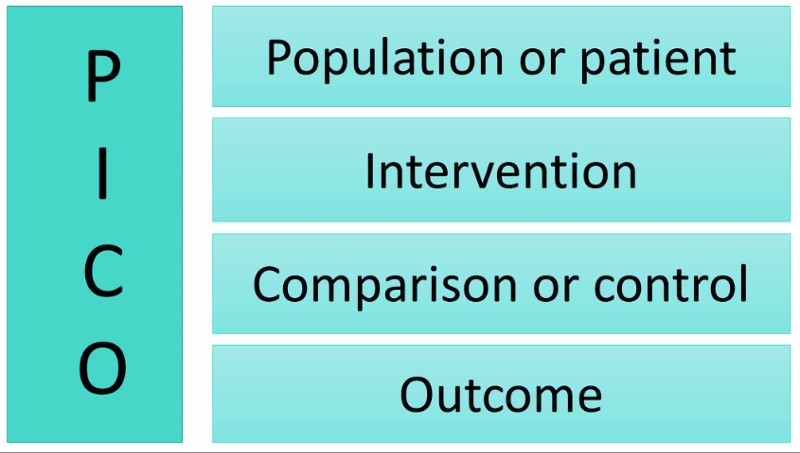

Navigating the vast ocean of clinical literature can feel like trying to find a needle in a haystack, especially when the stakes are high in evidence-based practice.
Formulating a precise clinical research question is like setting a course with a reliable compass—it points you in the right direction and ensures you reach your destination efficiently. In this journey, the PICO question framework serves as your trusted navigator, helping you craft focused, answerable questions that are crucial for high-quality clinical research and evidence-based practice.
In this article, we will dive deep into the PICO question format, exploring its elements, benefits, and practical applications. We’ll also discuss common pitfalls, variations like PICOT and PEO, and provide practical tips for formulating well-built questions. By the end of this article, you’ll be equipped to sail smoothly through the sea of clinical research with confidence.
PICO stands for:
This framework is essential in evidence-based practice and clinical research as it helps clarify the key components of a question. By breaking down the question, researchers can focus their literature search and find the most relevant studies. This precision not only saves time but also enhances the relevance and quality of the evidence gathered.

Defining the target population is crucial for any question. It involves specifying the characteristics of the patient group or the problem being addressed. For instance, when studying heart attacks, focusing on adolescents with a history of recurrent attacks can make the research more targeted and relevant.
Intervention refers to the treatment, test, or exposure being considered. For example, evaluating a new diagnostic test for heart attacks provides a clear focus for the research. This element helps with identifying the exact intervention that is being investigated.
The comparison element is what sets the intervention against an alternative. This could be the current standard treatment or a placebo. For instance, comparing the new diagnostic test to the standard test helps determine its relative effectiveness.
The outcome measures the desired effect of the intervention. This could be anything from reduction in recurrent heart attacks to improvement in patient quality of life. Clearly defining the outcomes helps in assessing the intervention’s impact.
A well-built question enhances the search strategy and literature review process. By clearly defining each element of PICO, researchers can streamline their searches, making them more precise and relevant. For instance, using specific elements in search queries can significantly narrow down the results to the most pertinent studies.
The PICO framework supports evidence-based medicine by structuring questions that directly inform clinical decisions. By aligning questions with clinical needs, it helps clinicians find the best evidence to support their practice, ultimately improving patient care.
PICOT adds a time frame element, making it more comprehensive for certain types of research. For example, studying the long-term effects of a new treatment over five years provides a clearer picture of its efficacy, safety and may guide future prognosis.
PEO (Population, Exposure, Outcome) is particularly useful for qualitative research, focusing on the exposure rather than the intervention. For instance, studying the impact of environmental exposure on asthma in children provides valuable insights into prevention strategies.
Using PICO involves several steps:
Structuring your question properly ensures that the research project is well-focused and the findings are relevant.
To help you start, here’s a simple worksheet:
Element
Population
Intervention
Comparison
Outcome
Description
Adolescents with recurrent heart attacks
New diagnostic test
Standard diagnostic test
Reduction in recurrent heart attacks
Common mistakes in making PICO questions include being too broad or too narrow, missing key components, or lacking clarity. To avoid these pitfalls:
PICO can be adapted for various study designs, including non-intervention studies.
For example, observational studies might focus more on exposures and outcomes, requiring adjustments to the traditional PICO elements.
The PICO method is a powerful tool for crafting effective questions. By breaking down complex questions into manageable parts, it helps researchers focus their inquiries, streamline their literature searches, and gather high-quality evidence.
Want to learn more about forming research questions for systematic literature reviews? Consider joining our course “Complete Guide to Database Searching for Systematic Reviews”.
4 Comments.
Greate article. Keep writing such kind of info on your blog.
Im really impressed by your blog.
Hello there, You have performed an excellent job. I’ll certainly digg it and in my opinion recommend to my friends.
I am confident they will be benefited from this web site.
Very descriptive blog, I liked that a lot. Will there be a part 2?
It’s an awesome piece of writing in support of all the web viewers;
they will take benefit from it I am sure.
Wow, this paragraph is nice, my sister is analyzing these kinds
of things, therefore I am going to let know her.